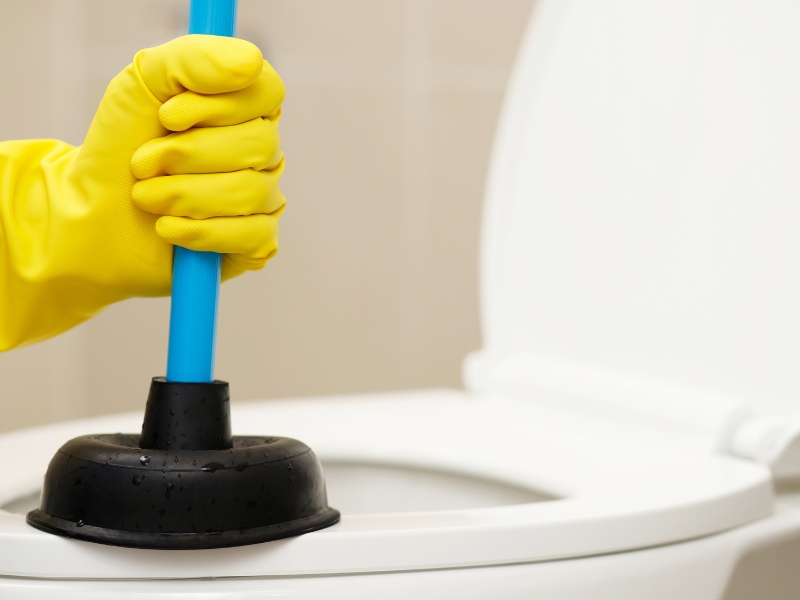When a blocked toilet causes overflows, it can quickly become a messy and stressful experience. You’re suddenly faced with dirty water, unpleasant odours and the potential for water damage right in the comfort of your bathroom. Whether you live in a busy part of Sydney or a quiet suburb, plumbing issues can strike without warning. The good news is that there are practical steps you can take to manage the situation and reduce the chances of it happening again. This article explores what causes toilet overflows, how to respond safely, and when to call a professional for help.
What causes a blocked toilet to overflow suddenly?
A blocked toilet can overflow for several reasons, often resulting from blockages and plumbing system issues. It’s essential to understand the root causes to avoid future problems.
- Clogged pipes: Blockages due to toilet paper, sanitary products, or foreign objects blocking the pipes.
- Flushing improper items: Items like wet wipes, cotton buds, and nappies can cause significant blockages, often leading to overflows.
- Low-pressure water supply: Blockages may form when there’s not enough water pressure to push waste through the pipes.
- Tree root intrusion: Roots growing into the sewer lines can obstruct waste and water flow, causing blockages.
- Septic tank issues: Overfilled or malfunctioning septic tanks can lead to waste backup and overflow in your toilet.
Can a blocked toilet cause overflow into other drains?
Yes, it is possible for a blocked toilet to cause overflow into other drains in your home. This typically happens when the blockage in the toilet’s pipes or sewer line is severe enough to create a backup throughout your plumbing system.
- Overflow in sink and bathtub: A blocked toilet may cause water to back up into other fixtures, such as sinks or bathtubs, especially if there’s a shared drain line.

- Smelly drains: Stagnant water from the overflow can cause foul odours to spread through your home, making the situation even more unpleasant.
- Increased water pressure: The overflow can increase the water pressure in your pipes, leading to leaks or even burst pipes in more severe cases.
This overflow can create a domino effect throughout your plumbing, but understanding various ways to clear bathroom drain blockages and prevent future issues can help you tackle the problem before it spreads.
When is an overflow considered a plumbing emergency?
Not all overflows are equal. Some may be minor inconveniences, while others can be plumbing emergencies. Understanding when an overflow is an urgent issue can help you avoid significant damage to your home.
- Large-scale overflow: If the overflow is significant and spreading rapidly, it’s a plumbing emergency that requires immediate attention.
- Water contaminants: If the overflow is wastewater, this can be a health hazard, requiring prompt expert intervention.
- Continuous backup: If the overflow keeps happening despite attempts to fix it, this indicates a more serious issue with your plumbing system.
- Sewer line problems: Persistent overflows could signal a problem with your sewer line, which, if not addressed quickly, could lead to expensive repairs.
A blocked toilet overflow becomes an emergency when it spreads quickly, involves wastewater, happens repeatedly, or indicates an underlying issue with your sewer line. In these urgent situations, it’s crucial to get help from experienced blocked toilet plumbers to fix blocked toilets promptly and prevent further damage.
What tools do experts use when a blocked toilet causes overflow?
Expert plumbers use specialised tools to diagnose and fix blocked toilets and prevent further overflow issues. These tools help clear blockages effectively and quickly.
- Plungers: Simple yet effective tools to dislodge minor blockages in the toilet.

- Drain snakes: Long, flexible tools used to break up stubborn blockages deep within the pipes.
- Hydro jetting: High-pressure water jets clean and clear drains, removing stubborn debris and buildups.
- Camera inspections: Plumbers use cameras to inspect pipes and identify the exact cause of the blockage.
These tools allow plumbers to address both surface-level clogs and complex, hidden issues, ensuring the blockage is not only cleared but also less likely to return.
Is it safe to use the toilet after an overflow?
After an overflow, it’s crucial to assess the safety of using your toilet. Continuing to use a blocked toilet can cause more damage and worsen the problem.
- Damage to plumbing: Continued use of a blocked toilet can put extra strain on the plumbing, leading to more severe issues.
- Risk of more overflows: Using a blocked toilet could cause the overflow to happen again, especially if the blockage hasn’t been cleaned properly.
- Potential health hazards: Overflowing toilets release wastewater containing bacteria and pathogens, making it best to avoid use until the blockage is resolved. Preventing such issues requires understanding the importance of proper waste and sewage disposal.
How to prevent your toilet from overflowing again?
Preventing a toilet from overflowing starts with regular maintenance and making a few simple changes in how you use it.
- Limit toilet paper use: Use toilet paper sparingly and avoid flushing large amounts at once.
- Avoid flushing non-flushable items: Never flush items such as wipes, cotton balls, or sanitary products.
- Regular drain maintenance: Have your drains cleaned regularly to prevent blockages from forming.
- Check water pressure: Ensure your water pressure is adequate to avoid slow flushes that could lead to blockages.
- Inspect the septic system: If you rely on a septic tank, ensure it is regularly pumped and maintained.
Preventing future overflow issues involves using your toilet properly, maintaining your plumbing, and monitoring the health of your septic system.
Conclusion
Dealing with a blocked toilet that causes an overflow can be stressful and messy. However, with the proper knowledge and swift action, you can minimise the damage and restore your plumbing system. Start by turning off the water supply to prevent further overflow, then use a plunger to attempt to dislodge the blockage.
If you’re dealing with a stubborn overflow, rely on Eco Plumbers 24/7 for prompt and effective toilet overflow solutions.

